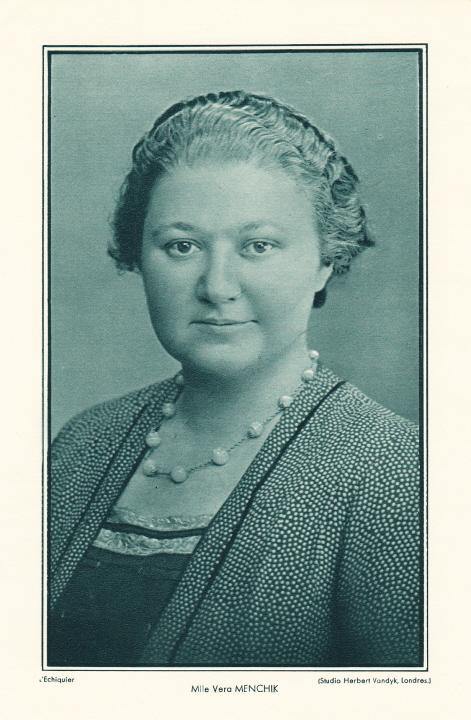
Edward Winter

L’Echiquier, 2 August 1933 (C.N. 7721)
From Ed Tassinari (Scarsdale, NY, USA):
‘Writing in the New York Times, 8 May 1988, in a review of the musical Chess, Harold Schonberg, referring to Vera Menchik, says the following:
‘For some reason there never has been a great woman chess player. There have been such talented ones as Vera Menchik, the Russian who at one time or another had victories against the best – Capablanca, Alekhine and the other giants of the 1930s – but she never was able to win an international tournament.’
Although the members of the “Vera Menchik Club” included any number of notables, neither Capablanca nor Alekhine ever made the list.’
(1663)
Writing about the Club on page 212 of Grandmasters of Chess (Philadelphia and New York, 1973) Schonberg had not made the mistake about Capablanca and Alekhine.
Chess writers seldom compose more than a few lines about Vera Menchik without mentioning that male players defeated by her became, ipso facto, members of the Vera Menchik Club, but what is known for sure about the origins of this cardinal component of chess lore?
The passage below is from page 313 of The Encyclopaedia of Chess by A. Sunnucks (London, 1976):
‘The following year [1929] she played in Paris and Carlsbad, and it was at Carlsbad that the famous Menchik Club was formed. The invitation to Vera Menchik to compete among such players as Capablanca, Euwe, Tartakower and Nimzowitsch was received with amusement by many of the masters. The Viennese master Becker was particularly scornful, and in the presence of a number of the competitors he suggested that anyone who lost to Vera Menchik should be granted membership of the Menchik Club. He himself became the first member. Other famous players who later joined the club were Euwe, Reshevsky, Sultan Khan, Sir George Thomas, C.H.O’D. Alexander, Colle and Yates.’
At Carlsbad, 1929 Vera Menchik finished last with a score of +2 –17 =2. On page 64 of the 4/1980 Boletín Ajedrez Radio Rebelde José Luis Barreras purported to quote the exact words of an announcement by Albert Becker:
‘When the tournament is over, I propose to open the Vera Menchik Club, whose members will be solely masters defeated by the lady world champion.’
We have yet to find any such reference in 1929 sources, although on page 19 of the Carlsbad, 1929 tournament book Hans Kmoch wrote:
‘Bange Sorgen bereitete sie dem Wiener Meister, der sich vor dem Turnier verpflichtet hatte, fortan als Ballettmädel aufzutreten, falls Fräulein Menschik mehr als 3 Punkte erzielt. Er hat sein Gelübde längst bitter bereut und wird solches nie mehr tun. Seinen Namen will ich diskreterweise verschweigen, ich verrate nur, dass er auf “Hans” getauft ist, sich anfangs mit “K” und zu Ende mit “ch” schreibt.’ (English translation: ‘She caused fearful anxiety to the Viennese master who, before the tournament, undertook thenceforward to go on stage as a ballerina if Miss Menchik scored more than three points. He has long since bitterly repented his vow and will never again act in such a way. I shall discreetly conceal his name, disclosing only that he was baptized “Hans” and that his surname begins with a “K” and ends with “ch”.’)
By the early 1930s the Club was becoming a familiar piece of whimsy. For example, the following appeared in a report about Hastings, 1930-31 on page 54 of the February 1931 BCM:
‘Sir George Thomas once again lost to Miss Menchik and is now acclaimed as president of the “Menchik Club” – the membership of which is strictly limited to victims of the woman champion.’
Tartakower (a participant in Carlsbad, 1929) wrote a few lines about the Menchik Club on page 70 of Neue Schachsterne (Vienna, 1935), but without indicating who had originated it.
(3433)
Harrie Grondijs (Rijswijk, the Netherlands) draws attention to an illustration opposite page 288 of the May 1935 issue of El Ajedrez Español:

(5202)
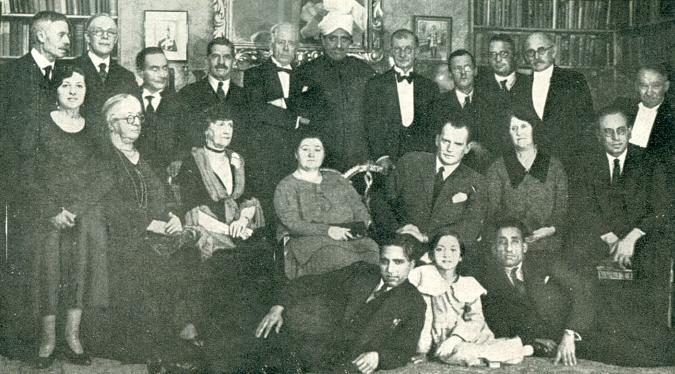
Centre background: Colonel Nawab
Sir Umar Hayat Khan
Back row (left to right): C.D. Locock, R.H.S. Stevenson, P.W.
Sergeant, C. Wreford Brown, Sir Ernest Graham-Little, M.P., R.C.
Griffith, F.D. Yates, J. du Mont, A. Rutherford, J.B. Whieldon
Next row: Miss Joseph, Mrs Latham, Mrs Arthur Rawson, V.
Menchik, A. Alekhine, Mrs Stevenson, J.A. Seitz.
Foreground: S. Basalvi, Aziz, Mir Sultan Khan.
The photograph came from the February 1932 BCM, and the magazine’s key has been given. Page 71 explained the occasion:
‘Colonel Sir Umar Hayat Khan arranged one or two receptions at his residence in honour of Dr Alekhine, the champion of the world. On each evening a dinner followed, characterized by all Sir Umar’s well-known hospitality. On 15 December after full justice had been done to the repast, speeches were made by Sir Ernest Graham-Little, MP, J. Whieldon, C. Wreford Brown and R.C. Griffith; Miss Vera Menchik and Dr Alekhine himself responded to the good wishes and thanks accorded them by the company.
The group photo we give as frontispiece was taken by Malik Ghulam Mohammed Khan, one of the most trusty of Sir Umar’s entourage and a warrior of great distinction. The small photo hanging on the wall to the right of the mirror (behind R.C. Griffith and F.D. Yates) shows Sir Umar in his official robes as Herald of the Princes at the great Durbar.’
(5602)
The frontispiece of the February 1926 BCM:
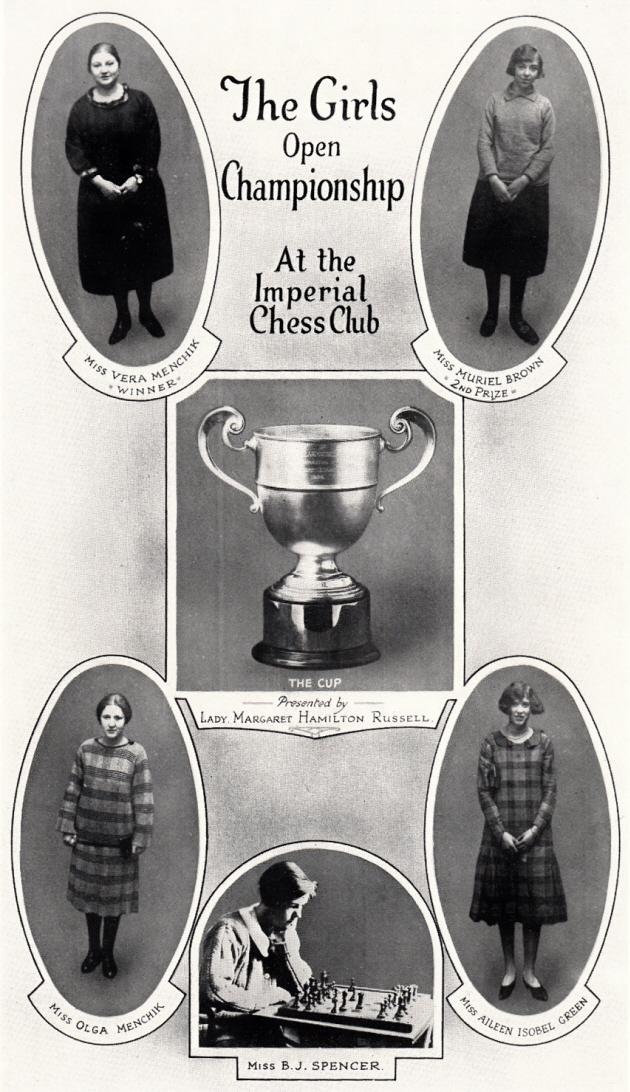
(8774)
From page 10 of Curious Chess Facts by Irving Chernev (New York, 1937):
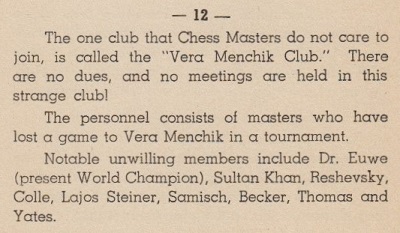
See too pages 6-7 of Chernev’s Wonders and Curiosities of Chess (New York, 1974).
Max Euwe mentioned the Club on page 110 of the April 1953 Chess Review:
‘We know that Vera included in her list of victims the names of a number of reputable masters forced, in one contest or another, to bite the dust.
It has more than once been suggested that these losers band themselves together to form a “Menchik” Club, pressing me, as a two-time loser (Hastings, 1930-31 and Hastings, 1931-32), to become its president. These plans have remained plans.’
For reasons undisclosed, the account of the Club on page 237 of Impact of Genius by R.E. Fauber (Seattle) asserted that Vera Menchik ‘outraged the male players by accepting an invitation to the great Carlsbad, 1929 tourney’.
On pages 18-19 of Women in Chess (Jefferson, 1987) John Graham stated that at Carlsbad, 1929 Becker ‘jokingly suggested that if anyone lost to her they would be inducted into the Vera Menchik Club’. Graham concluded:
‘Menchik did not have a good result in the tournament, and finished in a tie for last place with Vasja Pirc, Gideon Stahlberg and others.’
In reality, Vera Menchik finished alone in bottom place at Carlsbad, 1929, three points adrift. Neither Pirc nor Ståhlberg played in the tournament.
(9753)
From page 108 of Das Spiel der Könige by Alfred Diel (Bamberg, 1983):

At Carlsbad, 1929 Vera Menchik lost her game against Edgard (not Edgar) Colle, played on 15 August 1929 (see page 260 of the tournament book). In June she had defeated him at a tournament in Paris (L’Echiquier, July 1929, pages 290-292).
(11079)
It is quaint today to re-read our brief item C.N. 827, written in 1984:
Go through the standard anthologies and count the number of different Vera Menchik games on offer to illustrate her powers. If you find more than three you will have done better than us. Is it a ‘simple’ case of nobody having bothered to research her career, or did she not produce more than a handful of games worth remembering? (If the latter case, it might be because few women opponents of the time could give her a worthy game.)
The following was added on page 235 of A Chess Omnibus:
CHESS, 14 June 1937 (page 349) described the two contenders for that year’s women’s world championship:
‘Sonja Graf is the gay, the volatile; Miss Menchik the quiet and homely. Sonja Graf smokes endlessly; in the rare intervals between cigarettes she violently chews sweets. Between moves she rushes round the room, exchanging a few quick words with all and sundry; at the board her hair is dishevelled, her face drawn and anxious, her whole bearing tense to the point of painfulness. She blunders – and achieves brilliancies.
Miss Menchik on the other hand sits, plump and placid, her arms folded before her, not a muscle twitching through hours of play. We cannot remember having seen her smoking a cigarette. Her play rarely departs from a steady standard of calm solidity.’
Sir George Thomas on Vera Menchik:
‘Miss Menchik was not merely the best woman chessplayer the game has produced; she was so far ahead of the rest as to be in a class apart – the only woman who has won (and won beyond cavil) a place in the ranks of the masters. That is a fact clearly established by her record during the past 20 years or so. Equally true it is that her hold on the regard of the chess world was due as much to her other characteristics as to the force of her play. No one could wish for a more sporting or considerate opponent whether in success or in defeat, and I know no player less given to making excuses for failure or displaying undue elation when victorious. In spite of her unique position she was as unassuming today as when she started to climb the chess ladder – a pleasingly unaffected attitude equally free from “side” and from that false modesty which can be even more irritating. Consequently her triumphs were always popular and she had a host of well-wishers.’
Source: The Kipping Chess Club Year Book 1943-1944 (Liverpool, 1944), page 5.
(2923)
A game from one of A.G. Laing’s score-books (which were referred to in C.N. 8728):
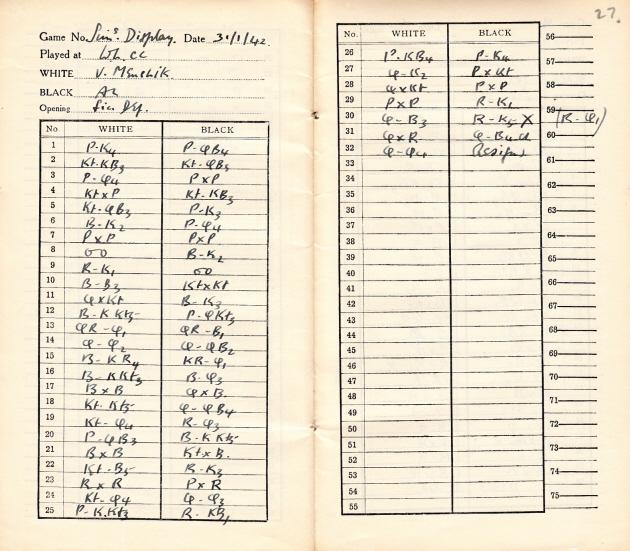
Vera Menchik – A.G. Laing
London, 31 January 1942
Sicilian Defence
1 e4 c5 2 Nf3 Nc6 3 d4 cxd4 4 Nxd4 Nf6 5 Nc3 e6 6 Be2 d5 7 exd5 exd5 8 O-O Be7 9 Re1 O-O 10 Bf3 Nxd4 11 Qxd4 Be6 12 Bg5 b6 13 Rad1 Rc8 14 Qd2 Qc7 15 Bh4 Rfd8 16 Bg3 Bd6 17 Bxd6 Qxd6 18 Nb5 Qc5 19 Nd4 Rd6 20 c3 Bg4 21 Bxg4 Nxg4 22 Nf5 Re6 23 Rxe6 fxe6 24 Nd4 Qd6 25 g3 Rf8 26 f4
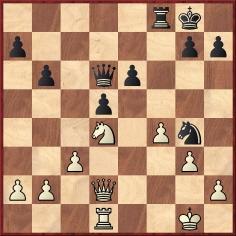
26...e5 27 Qe2 exd4 28 Qxg4 dxc3 29 bxc3 Re8 30 Qf3 Re4 31 Qxe4 Qc5+ 32 Qd4 Resigns.
The display was referred to on page 55 of the March 1942 BCM:

(8762)
There follows a selection of Menchik pictures that we have shown in C.N.:
This photograph by Erich Auerbach of Menchik and Mieses comes from The Quiet Game by J. Montgomerie (London, 1972). Can readers identify when it was taken?
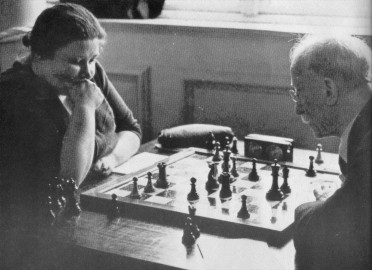
This photograph of Olga and Vera Menchik in Hastings was published on page 3 of the January 1930 American Chess Bulletin:
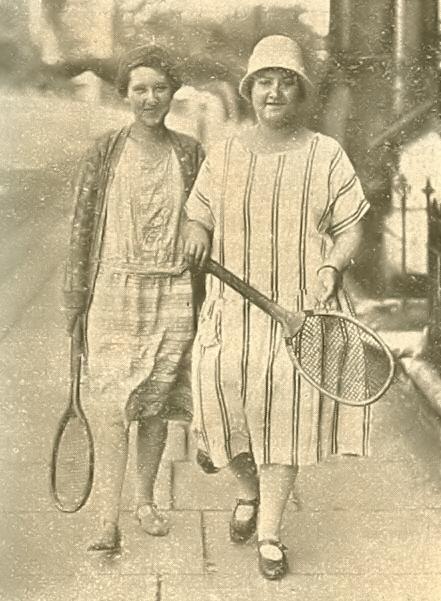
(5964)
From opposite page xvi of the Prague, 1931 tournament book:

(6548)
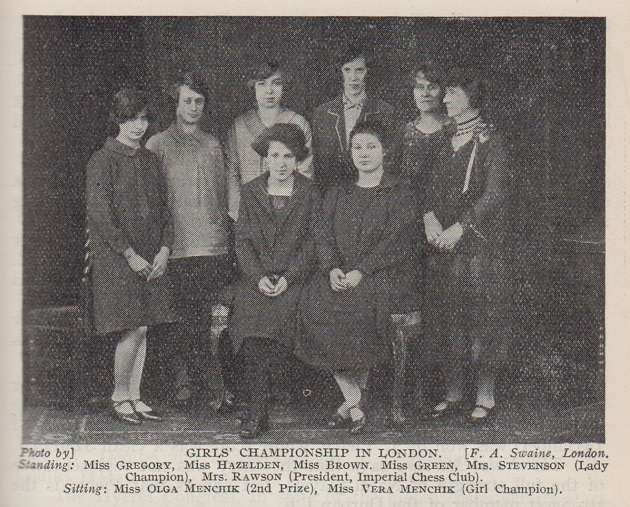
BCM, March 1927, page 113

BCM, February 1928, opposite page 57
After her marriage, briefly reported on page 219 of CHESS, 14 February 1939, she was referred to as ‘Mrs O. Menchik-Rubery’ (BCM, June 1939, page 242), ‘Mrs Rubery’ (BCM, April 1942, page 80) and ‘Mrs Rubery (Olga Menchik)’ (BCM, June 1943, page 128).
(9053)
Karel Mokrý (Prostějov, Czech Republic) informs us that he investigated this Moscow, 1935 photograph in the 1980s and drew up the key given below:
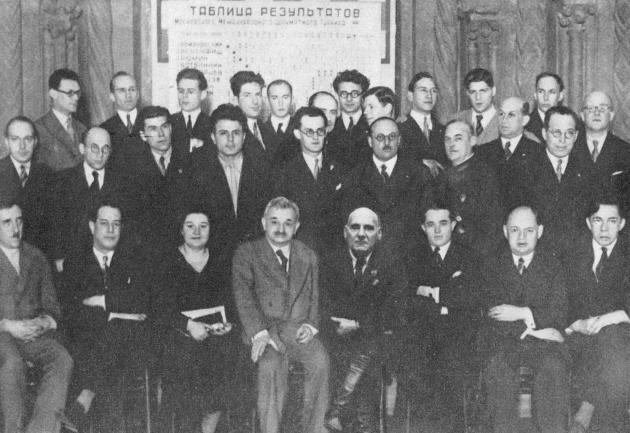
Mr Mokrý also mentions an article which he has written on the two variations of the Russian-language tournament book and the subsequent removal of Krylenko’s name and contribution. See under ‘Moscow 1935’ in the ‘Collector’s Corner’ of our correspondent’s webpage.
(7286)
Vera Menchik contributed a brief article to the Daily Mail, 5 August 1927, page 8:

(9074)
This photograph comes from page 49 of Famous Chess Players by Peter Morris Lerner (Minneapolis, 1973):
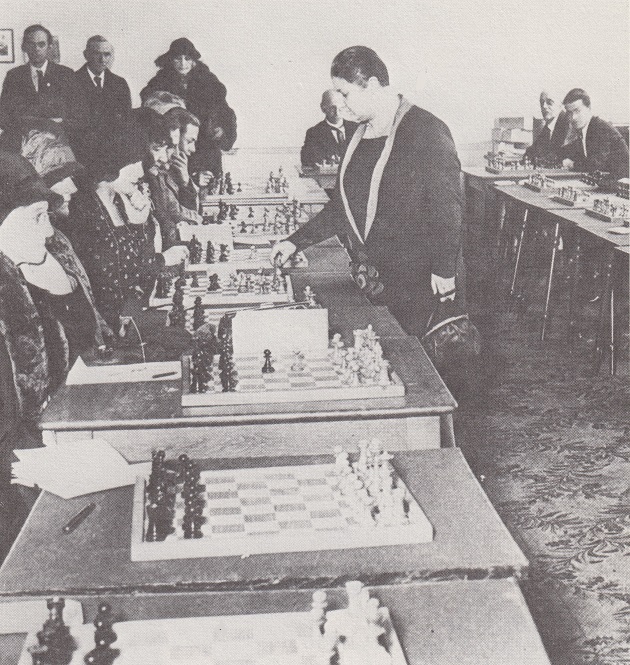
The caption on the previous page stated that the picture was taking during a 20-board simultaneous display in London in 1931. According to page 24 of the Daily Mirror, 7 February 1931, which also printed the photograph, the exhibition took place on 6 February.
Two other photographs from the same newspaper are reproduced below. Can good-quality copies be found?
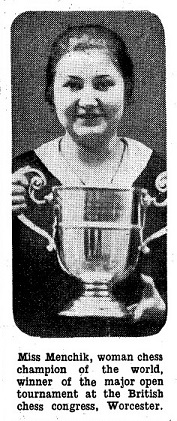
Daily Mirror, 24 August 1931, page 20

Daily Mirror, 17 April 1935, page 17.
(9849)
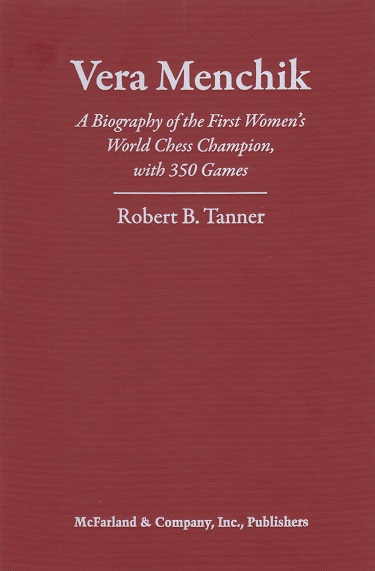
McFarland & Company, Inc. has let itself down badly with Vera Menchik by Robert B. Tanner (Jefferson, 2016).
Far smaller than most of the company’s chess biographies, it is also far sloppier. A 15-minute skim of the General Index revealed about 30 misspellings, most of them obvious (e.g. ‘Folkstone’, ‘Jermey’ Gaige and ‘San Sebastion’). The unimpressive Bibliography includes an entry with errors in authorship, title and date:
Vera Menchik by Robert B. Tanner has been consigned to the bottom of our reading pile.
(10191)
On successive days, by chance, monographs on Vera Menchik have been received, today’s arrival being Královna šachu Věra Menčíková by Jan Kalendovský (Prague, 2016).
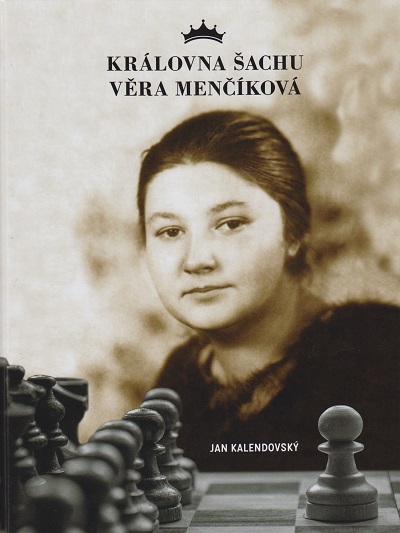
Karel Mokrý’s excellent online chess shop has information about the book.
(10192)
Pages 563-571 of the latest edition (‘Spring 20/2019’) of the Quarterly for Chess History are devoted to a review-cum-demolition by the Editor, Vlastimil Fiala, of Vera Menchik by Robert B. Tanner (Jefferson, 2016). The final paragraph states that the book ‘should never have gone to print’.
As mentioned in C.N. 10191, the Menchik book is indeed very weak, but with his own track-record Vlastimil Fiala is an unsuitable person to complain, as he does on page 570, that it has ‘a large number of typos’. The review itself includes ‘J. Kaledovský’, ‘St Leonard’s’ (four times), ‘Bell’s of London Life’, ‘Sir G.H. Thomas’, ‘E. Eales’, ‘L’Echiquer’ (twice), ‘Hastings 19028/9’ and ‘Carslbad’.
Elsewhere, this new issue of the Quarterly contains, on pages 226-263, an article about Vienna, 1882 which refers to Berthold ‘English’, instead of Englisch, nine times. Pages 300-311 present some games played by Staunton in Scotland with the misspelling ‘Edinburg’ 12 times. On page 387 a game lost by Alekhine is dated ‘11.12.2930’. A sentence on page 420 refers to ‘Casablanca’ and ‘Miss M.T. Morra’.
(11232)

Illustrated Sporting and Dramatic News, 22 January 1927, page 167
(10307)

This photograph by Erich Auerbach from The Quiet Game by J. Montgomerie (London, 1972) was shown in C.N. 3687, with the question of when it was taken.
From Philip Jurgens (Ottawa, Canada):
‘Vera Menchik and Jacques Mieses played a ten-game match between 21 May and 13 June 1942. He was aged 77, some 41 years older than her. Menchik won by four games to one with five draws. Page 208 of Robert B. Tanner’s book on Menchik (C.N. 10191) described it as “the first ever serious match between a woman and a strong master”.
According to the West London Chess Club website, Vera Menchik joined in 1941 after the National Chess Centre was bombed in the Blitz. Jacques Mieses was also a club member during the Second World War. It is therefore quite likely that they played their match under the auspices of the West London Chess Club and that the photograph was taken during that period.
The above website also states:
“During World War II, very few clubs remained open, but thanks to the determination of the officers, West London Chess Club persevered and invited players from other clubs to play. This brought more strong players to the club, including the likes of Jacques Mieses, Vera Menchik, Sir George Thomas, and briefly, Capablanca [sic].”’
(11981)
Jan Kalendovský (Brno, Czech Republic) has sent us page 5 of the 2 August 1931 issue of Wiener Bilder, and the chess part is reproduced below:

The caption on the right correctly names the line-up of the victorious US team in the Prague Olympiad but identifies the woman as Vera Menchik. Who was she really?
(6154)
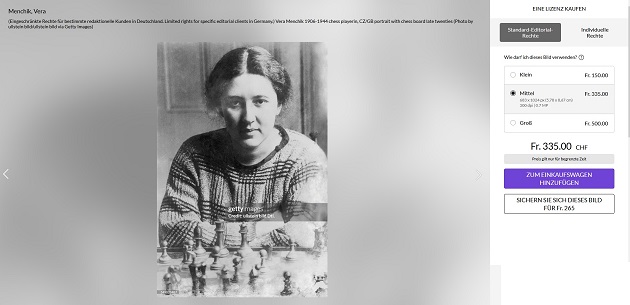
No information is available on whether any chess outlet has ever paid money to getty pictures for a large, clean copy of the above photograph. Nor do we know why it is believed to show Vera Menchik, as opposed to her sister Olga.
Complementing the images of the sisters in our feature article The Vera Menchik Club, below is a photograph from page 14 of the (London) Daily Chronicle, 13 January 1926:
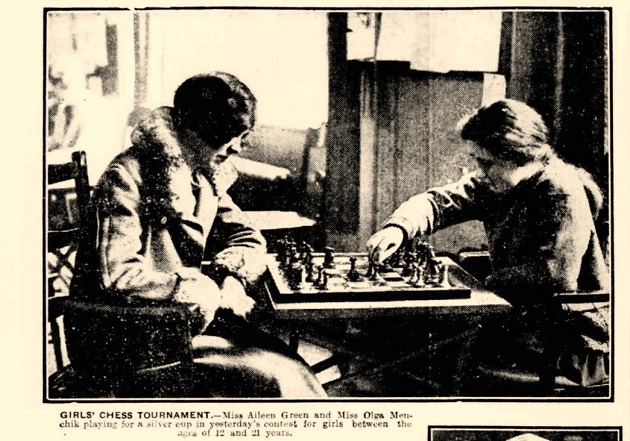
(12129)
The present batch of items ends on a low note, courtesy of page 9 of the Daily Express, 7 February 1931:
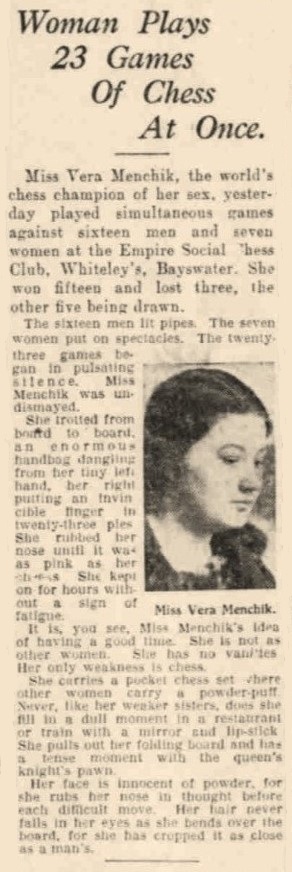
Page 16 of the newspaper had a photograph from the exhibition, a shot discussed in C.N. 9849.
(12201)
See too Chess and Women.
To the Chess Notes main page.
To the Archives for other feature articles.
Copyright: Edward Winter. All rights reserved.